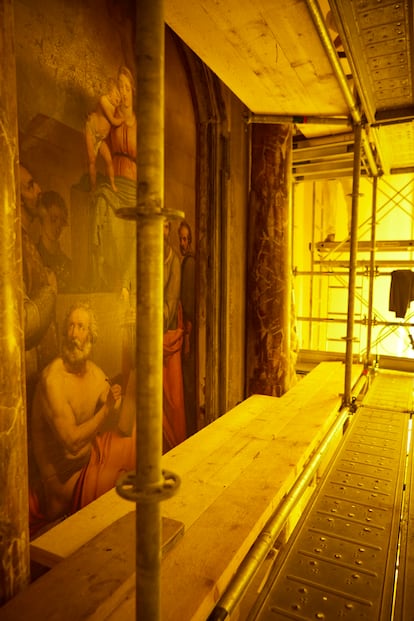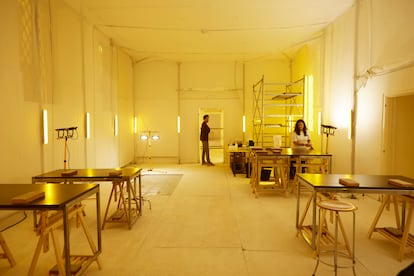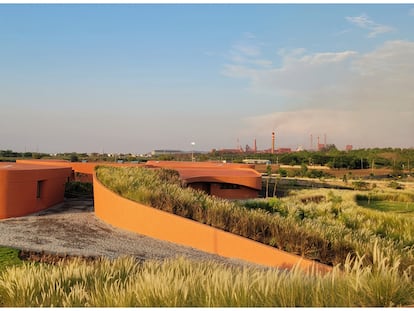The Holy See, the best pavilion at the Venice Biennale


This is as simple as some architects talking about the end of the world, and a group of architects pondered how best to start the afternoon. “This pavilion is very radical because it is extremely simple.” Tatiana Bilbao describes her intervention: architecture as care and collective responsibility. As an art capable of addressing contemporary social and ecological challenges, it coincides, in ambition, with Laudato Si , Pope Francis's encyclical that speaks, like Saint Francis of Assisi, of “treating the home as a sister”; that is, of the responsibility of sharing a common home. The Holy See pavilion at the Venice Architecture Biennale, which received a special mention among the award winners at this 19th edition, is on everyone's lips. It is different.
“Venice has a very difficult relationship with the Architecture Biennale. On the one hand, it supports it because it needs the income it generates. On the other, the architectural debate tiptoes around the city. It leaves no trace.” Anna Puigjener of MAIO Architects is the other designer behind the new Holy See pavilion in Venice. It is, in reality, a rescue intervention—rather than a restoration—that denounces the irrelevance of many architectural interventions during the Architecture Biennale. What is rescued can be a lot. Here, it's not just walls, frescoes, and physical architecture that are being repaired; it also restores the meaning of architecture, the Venetian cultural fabric, and the neighborhood communities of the Santa Maria Ausiliatrice church itself, converted into a social center in the Castello district, very close to the gardens that showcase the national pavilions. The intervention is, thus, pure Christianity. It truly rescues the poverty of spirit in which the most naked Catholicism finds true richness.
Just three editions ago, the Vatican's Dicastery for Culture decided, reconnecting with its centuries of artistic patronage, to commission a pavilion for the Venice Architecture Biennale. It happened in a big way: several of the world's most renowned architects— from Souto de Moura to Norman Foster —designed seven chapels in the gardens of the Monastery on the Island of San Giorgio Maggiore. These pavilions were so deeply felt, relating so naturally to the sparse vegetation that grows in Venice, that they became a permanent imprint.

However, that success, for the Pope and the Curia, could only have been architectural. They wanted more. “Their new cardinal, heading the Dicastery of Culture, indicated that art in the 21st century should put man—humanity—at the center,” explains Tatiana Bilbao. So, for the next edition, Álvaro Siza 's intervention in the monastery's garden consisted of tending the crops, opening an interior garden to neighbors and visitors, and sharing seeds and flowers for making infusions.
Along the same lines, at the last Art Biennial, Maurizio Cattelan 's intervention With my eyes forced visitors to go through the process of entering a women's prison: check-up, stripping... Once inside, you met some of the incarcerated women who had worked with the artists for a year.

This is the spirit with which three female architects conceived the new pavilion of the Holy See. Opera Aperta combines the opening of the work in the Church of Santa Maria Ausiliatrice to the residents of the Castello district with its rescue—they don't speak of restoration—and its conversion—at least temporarily—into a restoration school and social center. Let's see how it works.
Led by the young Portuguese cardinal José Tolentino de Mendoça, this time the selected architect was Tatiana Bilbao. The Mexican opted to work as she does when building social housing or public spaces: sharing the project. So, she called on Anna Puigjener (MAIO Architects) and Marina Otero Verzier , with experience curating at the Venice Biennale. Together they began brainstorming ideas: from dedicating the money to the restoration to converting that restoration into trade classes to learn how to work with plasterers, ceramists, painters, and restorers. The architects added Venetian Giovanna Zabotti, artistic director of Fondaco Italia, to the project. And she began to build bridges with neighborhood associations. Then came the social uses: beyond the workshops, the hospitality. From the conservatory, for example, they requested space so that musicians with larger instruments—pianists, percussionists—could rehearse there. Workshops and neighborhood meetings would have background music.
Thus, with an architecture that aims to avoid further damage to the church ruins and to prevent injury by using protective fabrics, scaffolding, and yellow emergency lights, Tatiana Bilbao ESTUDIO and MAIO Architects completed the project. The rest will be worked on by Otero Verzier and Zabotti with visitors, artisans, and local residents.

Built in the 12th century as a hospice for pilgrims, the building housing this pavilion was Venice's first hospital. In the 18th century, it became a kindergarten. In 2001, the Venetian City Council decided to allocate it for cultural use. Since then, it has been awaiting restoration. For the next four years, the Vatican will manage it based on guidelines established by the curators.
Last Friday, when the restoration work was inaugurated, an elderly neighbor was peering out of a window into the courtyard. It wasn't the old woman with the curtains. "She came down this morning to sweep the cloister," Bilbao told me. She was contemplating the miracle of seeing the ruin she saw from her window take on new life.
Do you want to add another user to your subscription?
If you continue reading on this device, it will not be possible to read it on the other device.
ArrowIf you want to share your account, upgrade to Premium, so you can add another user. Each user will log in with their own email address, allowing you to personalize your experience with EL PAÍS.
Do you have a business subscription? Click here to purchase more accounts.
If you don't know who's using your account, we recommend changing your password here.
If you decide to continue sharing your account, this message will be displayed indefinitely on your device and the device of the other person using your account, affecting your reading experience. You can view the terms and conditions of the digital subscription here.
EL PAÍS





%3Aformat(jpg)%3Aquality(99)%3Awatermark(f.elconfidencial.com%2Ffile%2Fbae%2Feea%2Ffde%2Fbaeeeafde1b3229287b0c008f7602058.png%2C0%2C275%2C1)%2Ff.elconfidencial.com%2Foriginal%2F8c8%2F942%2Fe77%2F8c8942e772a6964d7ca48a8e796cd6f7.jpg&w=1280&q=100)

